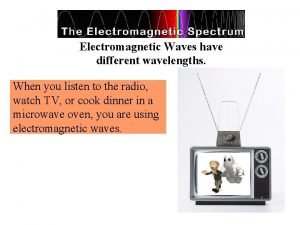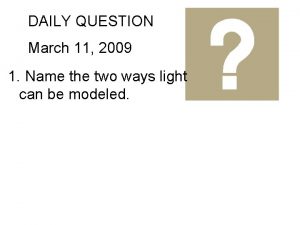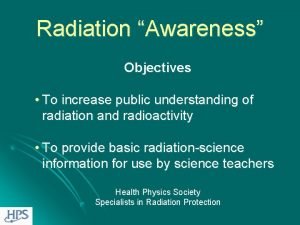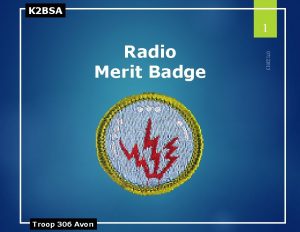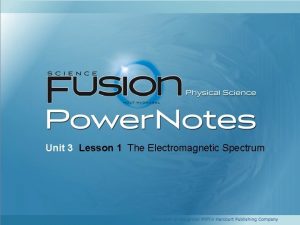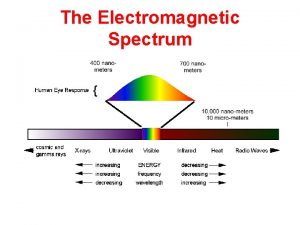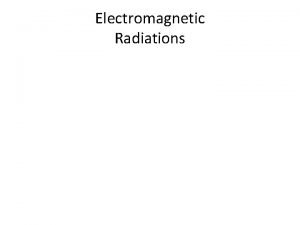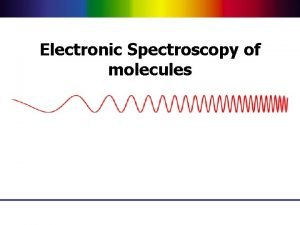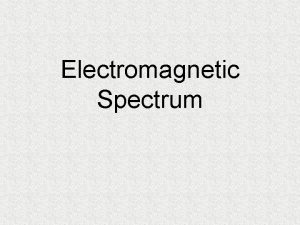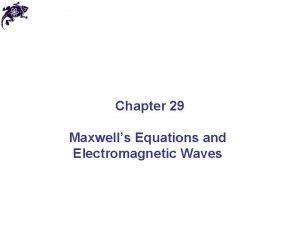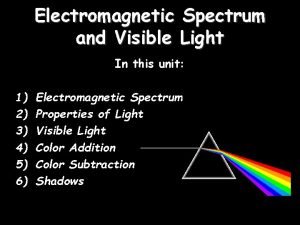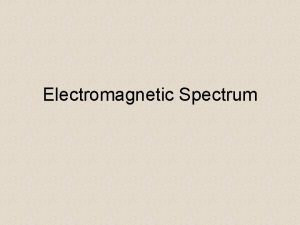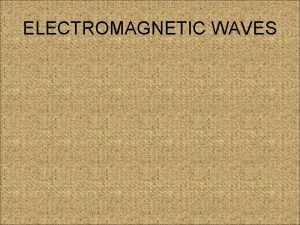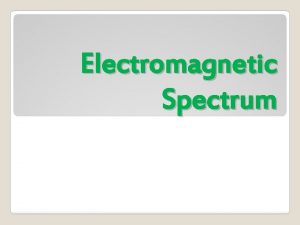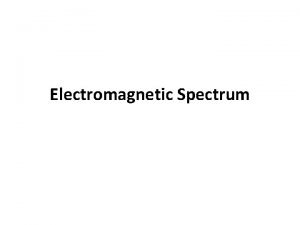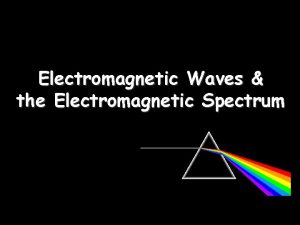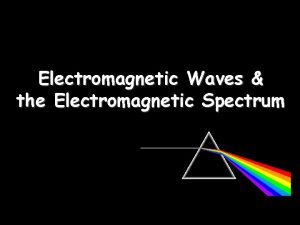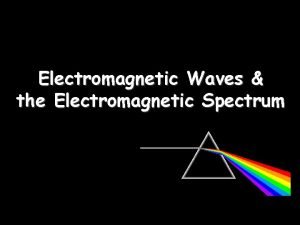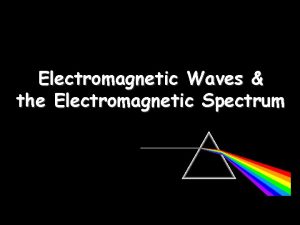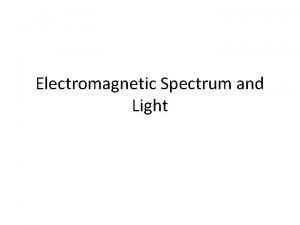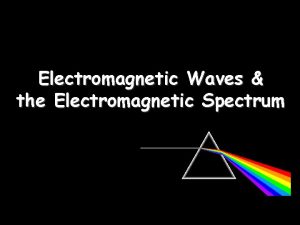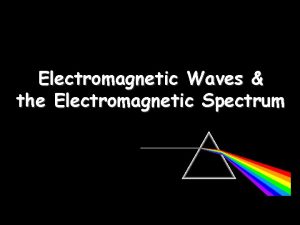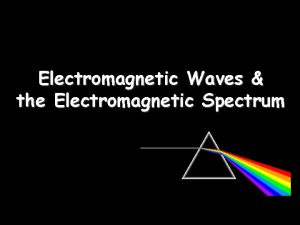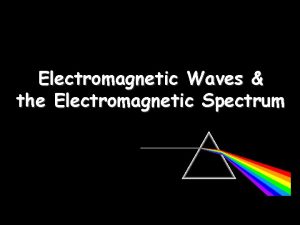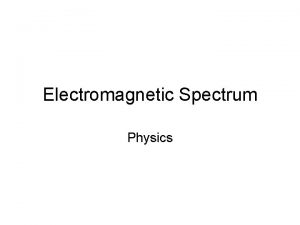The Electromagnetic Spectrum The electromagnetic spectrum consists of





















- Slides: 21

The Electromagnetic Spectrum The electromagnetic spectrum consists of the colors that we see in a rainbow from reds and oranges, through blues and purples.

What is the electromagnetic spectrum? • The visible spectrum is just one small part of the electromagnetic spectrum. These electromagnetic waves are made up of two parts. The first part is an electric field. The second part is a magnetic field. So that is why they are called electromagnetic waves.

What are waves? • Have you ever ridden a wave in the ocean? • Ocean waves travel on the surface of the water. You can see them and you can feel them. As you swim through the water, you can even make your own waves.

• Have you ever seen a flag on a windy day? • The wind creates waves in the flag. Both the waves in the flag and the ocean waves are waves that you can see. There are other kinds of waves. We cannot see these waves, but we experience them every day. These waves are called electromagnetic waves.

Sound Waves? • Sound is also a type of wave that we cannot see. • Like ocean waves, sound waves need a medium to travel through. Sound can travel through air because air is made of molecules. • These molecules carry the sound waves by bumping into each other, like Dominoes knocking each other over. Sound can travel through anything made of molecules - even water! There is no sound in space because there are no molecules there to transmit the sound waves.

What’s the difference between sound waves and the electromagnetic waves? • Electromagnetic waves are unlike sound waves because they do not need molecules to travel. • This means that electromagnetic waves can travel through air and solid materials - but they can also travel through empty space. • This is why astronauts on spacewalks use radios to communicate. Radio waves are a type of electromagnetic wave.

What are electromagnetic waves? • Electromagnetic waves are formed when an electric field (which is shown in blue arrows) couples with a magnetic field (which is shown in red arrows).

Electromagnetic Waves have different wavelengths. • When you listen to the radio, watch TV, or cook dinner in a microwave oven, you are using electromagnetic waves.

Waves!! • Radio waves, television waves, and microwaves are all types of electromagnetic waves. They only differ from each other in wavelength. Wavelength is the distance between one wave crest to the next.

• Waves in the electromagnetic spectrum vary in size from very long radio waves the size of buildings, to very short gamma-rays smaller than the size of the nucleus of an atom.

• What does "frequency" mean? • The frequency of a wave is the number of waves per second • What does "wavelength" mean? • The wavelength is the distance from the peak of one wave to the next one.

Wavelengths • High frequency, Short wavelength • Low frequency, Long wavelength – Shortest Waves to Longest • • Gamma Rays X-Rays Ultra-Violet Visible Light Infra-Red Microwave Radio Waves

Gamma Rays • Shortest wavelength. • These are nasty ones. They have very high energy and will even go through metals. • Gamma rays and X-Rays can cause cancer, but gamma rays can also be used to destroy cancer cells: this is radiotherapy.

X-Rays • X-Rays have so much energy and such a short wavelength that they can go right through you. • However, they cannot get through bone as easily as they can get through muscle. • This is because your bones contain so much Calcium.

Ultra Violet • These waves have very high energy and very short wave lengths; shorter than visible light. • Some animals like honey bees can see ultraviolet light. • Some plants have white flowers, at least you think that they are all white, but they may appear to be different colors to a honey bee because of the amounts of ultra-violet light which they reflect.

The Visible Spectrum • Red, Orange, Yellow, Green, Blue, Indigo, and Violet are the colors of the visible spectrum. ROY G BIV

Infra Red • These radio/light waves have a very short wavelength; their wavelength is longer than visible light. • Infra-red can be detected by special infrared film. • Animals like the pit-viper have infra-red detectors so that they can find their prey in the dark. • You have been warned!!!

Microwaves • Microwaves have such a short wavelength that they are very easily absorbed by water. • This is why they are used in microwave ovens. • What happens is that when the water in your TV dinner absorbs the microwaves, the energy of the microwaves is converted into heat: it makes the water molecules vibrate faster. Thus cooking your food.

Radio Waves • Radio waves have a much longer wavelength that light waves. The longest waves are several kilometers in length. The shortest ones are only millimeters long. • I like these waves; they are used for radio broadcasts, amateur radio, television, and mobile phones. • Different parts of the radio spectrum have been allocated to the various services.

Type of Radio Waves • Long Wave, around 1~2 km in wavelength. The radio station "Atlantic 252" broadcasts here. • Medium Wave, around 100 m in wavelength, used by BBC Radio 5 and other "AM" stations. • VHF, which stands for "Very High Frequency" and has wavelengths of around 2 m. This is where you find stereo "FM" radio stations, such as "Galaxy 101" and "GWR FM". Further up the VHF band are civilian aircraft and taxis. • UHF stands for "Ultra High Frequency", and has wavelengths of less than a meter. It's used for Police radio communications, military aircraft radios and television transmissions

 What is the electromagnetic spectrum
What is the electromagnetic spectrum The shortest wavelength
The shortest wavelength Electromagnetic spectrum mnemonic
Electromagnetic spectrum mnemonic Objectives
Objectives Kesler science properties of waves answer key
Kesler science properties of waves answer key Troop 306 avon
Troop 306 avon Electromagnetic spectrum foldable
Electromagnetic spectrum foldable Spectrum dmca
Spectrum dmca Electromagnetic spectrum
Electromagnetic spectrum Electromagnetic spectrum foldable
Electromagnetic spectrum foldable Electromagnetic spectrum foldable
Electromagnetic spectrum foldable Longest wavelength to shortest wavelength
Longest wavelength to shortest wavelength Wavelength formulas
Wavelength formulas The food
The food Electromagnetic spectrum table
Electromagnetic spectrum table Characteristics of ultraviolet rays
Characteristics of ultraviolet rays Electromagnetic spectrum
Electromagnetic spectrum теория максвелла
теория максвелла Darvill clara electromagnetic spectrum
Darvill clara electromagnetic spectrum Waves produced by stars and galaxies
Waves produced by stars and galaxies Rmivuxg how to remember
Rmivuxg how to remember Types of radiation in the electromagnetic spectrum
Types of radiation in the electromagnetic spectrum

